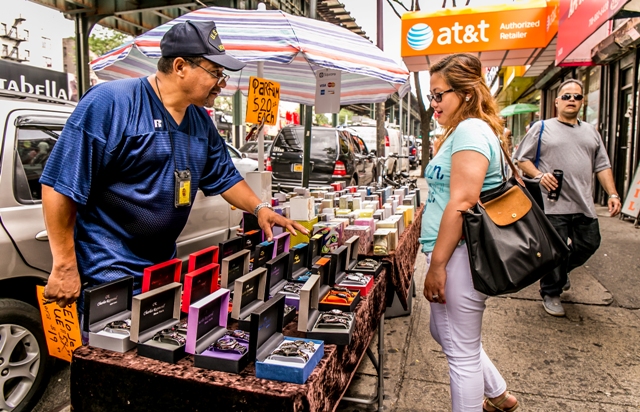
By DAVID CRUZ
As an army of vendors mobilize for an increase in street vending permits, business improvement districts in Norwood and Fordham are gearing up to prevent an increase of vendors abutting brick and mortar establishments.
Fears by the Jerome-Gun Hill Business Improvement District and Fordham Road Business Improvement District prompted their executive directors to initiate their own campaign countering a movement by The Street Vendor Project, an offshoot of the Urban Justice Center, which has been lobbying City Hall into lifting the cap on street vendor permits. As it stands there are 3,000 food vendor permits and 853 general merchandise vendor permits available, a figure that’s stood roughly the same since imposed in 1981 by the New York City Council.
At a June 25 meeting with Community Board 7’s Economic Development Committee, business stakeholders shared the dark side of vending to committee members and representatives of elected officials. Some illegal practices can involve legitimate vendors illegally subcontracting their vendor licenses, clogging streets and leaving mounds of trash behind. The long running argument remains from BID merchants: vendors threaten to siphon foot traffic and profits away from retail establishments who bear much higher overhead.
They also edge closer to brick and mortar establishments, a noticeable problem within the borders of the JGH-BID. “Sidewalks have been shortened. They’re not as wide as they used to be,” said Marcia Cameron, executive director of JGH-BID, home to some 200 stores. “Streets are used for so many things. You have to do a study before lifting the ban.”
Business improvement districts are special commercial zones where property owners pay a special tax assessment for cleaning and marketing services. Property owners typically pass the cost on to store owners.
Cameron was joined by Wilma Alonso and Daniel Bernstein, executive director and co-executive director of the Fordham Road Business Improvement District, the largest BID in the Bronx. Together they presented a four-page statement prepared by the New York City BID Association, a contingent of 72 BIDs across the city that warned a “unilateral, piecemeal change” to the current laws “will lead to unintended consequences.”
“We oppose any proposal to lift the cap on vending permits in the absence of a comprehensive, deliberate, and research-based study, with input from public stakeholders including business owners, property owners, and residents, as well as community boards…” read the statement.
For now, CB7 hasn’t taken an official position.
Vendors’ Struggles
In many instances, the decks appear to be stacked against prospective vendors, particularly those selling food, according to organizers from the Street Vendor Project. With only 3,000 food permits handed out yearly, in compliance with a 1981 City Council rule, waiting lists are common, sometimes taking years to be built. This pushes them to either work for a licensed vendor, enter the black market by renting a permit at an inflated price that can run upwards of $25,000 for two years (permits typically cost $200) or just illegally vend. They run the risk of heavy fines, which can go upwards of $1,000 for infractions that include vending too close to a storefront.
Fines are common by inspectors from the New York City Department of Health (DOH) or Department of Consumer Affairs, which share oversight in awarding licenses. But arrests can be effected. For the NYPD, arrests are not just part of the process, but logging merchandise that turns into evidence, according to Captain John Korabol, executive officer of the 52nd Precinct, which covers Norwood and parts of Fordham.
The limit on vendors has been seen as economically counterproductive for the Street Vendor Project, which has fought for years to improve conditions on behalf of those seeking permits.
“We have a lot of research about competition. Studies show that vendors are not competing with brick and mortar establishments. They are selling different items at different price points,” said Sean Basinki, director of the Street Vendor Project, which has met with 41 of the 50 City Council members in attempts to have them lift the cap. Their version of a bill involves the city Department of Small Businesses and the city DOH to issue an unlimited number of vendor licenses to effectively weed out the black market.
Basinki argues that more vendors translate to less unemployment and a sense of increased entrepreneurship. A vendor’s presence, Basinki claims, “gets people shopping.”
Every Vendor to Themselves
With stiff competition out on the streets, a kind of “every person for themselves” attitude courses through the world of vending. Along the Jerome-Gun Hill BID, legal vendors, all U.S. military veterans, expressed concern over the city issuing unlimited licenses.
“That’s going to push us out,” said Robert McDaniels, a 10-year Norwood vendor and U.S. Navy veteran who routinely sells his brand of watches and colognes in front of a general store. “That’s going to bring more problems, it’s gonna bring more laws, and more headaches for existing vendors.”
A charm bracelet vendor, a Riverdalian who only went by Ed, said he’d welcome new vendors so long as “they’re not in competition with me.”
“You don’t want too many because then they’ll flood the streets,” said Jim Lane, a Norwood vendor selling handmade pet tags.
For vendors, selling products can serve as a road to a brick and mortar establishment, a reason why Basinki can’t quite understand the vitriol towards vendors. “The animosity doesn’t make sense,” he said.
Editor’s Note: Minutes for CB7’s Economic Development Committee meeting will be posted on their website, www.bronxcb7.info.




